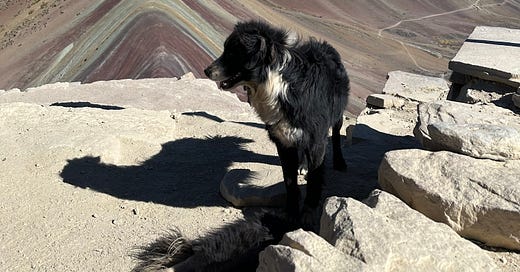This post is split into two parts. It’s also a little dramatic.
Part One
‘Who could fail to read the sermon in the stones of Newport? Who could think that the building of a railroad could guarantee salvation, when there on the lawns of the men who built the railroad nothing is left but the shadows of migrainous women, and the pony carts waiting for long-dead children?’
The Seacoast of Despair, Joan Didion
4 hours drive from Cuzco stands perhaps the most abundantly clear warning for our impending climate-related destruction I can ever remember witnessing.
Vinicunca, Montaña de Siete Colores or (as we know it) Rainbow Mountain has fast become a tourist hotspot. While Machu Picchu is of course the most offered destination by Cuzco’s many tour companies, Rainbow Mountain follows close behind.
Most tourists are picked up at 4am and carted to the base of the mountain where they can choose to walk for a couple of hours or ride a horse to the summit. Rory went a few days before me on one of these tours, and tells me most people chose the latter.
More astonishing than the now-famous bands of coloured rock, in my opinion, is that the mountain was only ‘discovered’ about 15 years ago. Before then, the area was covered by ice. The ice, of course, has recently melted. Something about fossil fuels, temperatures rising, all under control, being pragmatic etc.
The rapid changes to the Peruvian natural environment had been a feature of the Salkantay Trek too. We were repeatedly told that the views get less impressive every year due to the receding ice caps. One mirador advertised ‘8 snow-capped mountains!’ We could only see 3.
Our tour guide told us that when Machu Picchu was first officially discovered in 1912 it was overgrown, having been reclaimed by nature in the centuries since it was last occupied. Teams of archaeologists aided by locals carefully, painstakingly, excavated and restored the site. While they unsurprisingly made mistakes, the process was a remarkable achievement which I found deeply inspiring. They worked together, with no guarantee of any significant reward, and left something behind: a legacy. Over a century later, I feel gratitude and fortune to experience the incredible results of their selfless collaboration.
Exploring Rainbow Mountain means living a different legacy. One that will likely be shorter-lived. Will there be tourists exploring Machu Picchu in 100 years time, seeing the sun rise and the clouds lift? What else lies beneath our ice caps, previously destined to remain hidden? How many more Rainbow Mountains will be ‘discovered’, and then lost?
Part Two
Sometimes I fear my climate anxiety and (fairly) comprehensive knowledge in this area renders me unable to fully enjoy things like Rainbow Mountain. The truth is, my time exploring it and the nearby Red Valley was easily some of the most memorable and best of my trip so far.
The mountain itself is quite astonishing. A true freak of nature. The surrounding area is magnificent, some of the best views I’ve seen. Rugged, colourful mountains adorned with snowy peaks and deep valleys all largely unspoiled. It also smashed my altitude record of the Salkantay Pass, clocking in at 5,036m!
Our decision to rent cars and drive a little later in the day proved masterful. The place was empty, which I’ve been told is not the experience most have. There were 7 of us, including a few from the Salkantay Trek, and we made the most of our solitude up there. The wind was sharp but simultaneously peaceful. Birds danced above us. A dog appeared at the summit, to our collective delight. It was all perfectly quiet. And truly beautiful.
The road back to Cuzco is long, lined with alpacas and varies dramatically in quality. A narrow, gravelly track carved through hillsides at once becomes the cobbled high street of a quaint Andean town. It soars high above the tree line before crashing down to trace the path of a bustling river. Unlike beneath the foothills of Machu Picchu, this area remains largely underdeveloped.
Rainbow Mountain is undoubtedly worth visiting, but I do think it’s important to understand its history before doing it. Ultimately it should not exist as a tourist destination, or even as a natural wonder. It is a picturesque reminder of a grotesque truth.



